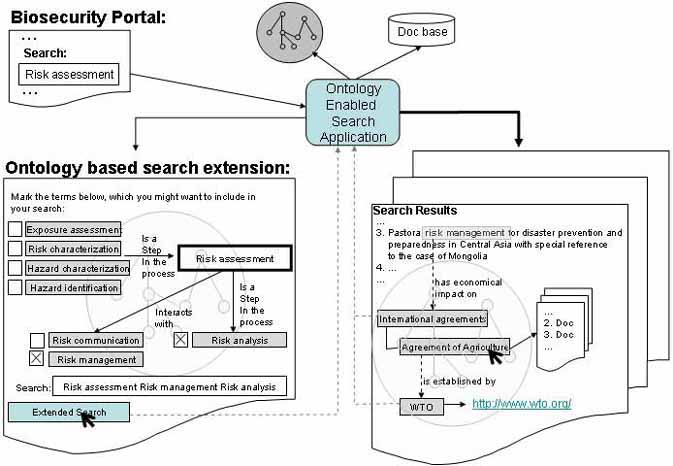In this section, an outlook on future work within this project and follow-up projects in context of the AOS framework will be given. As previously discussed, a domain ontology, which can be developed applying the above framework, only sets the basis for efficient information management and retrieval. Applications, using this background knowledge are still rare and further investigation is required. This section sketches a likely scenario for ontology use in the discussed domain and outlines some already existing sample applications and their possible implications for the AOS project.
6.1. Facilitation of better search and information retrieval
Using the ontology to extend currently performed keyword search, is the most direct application. Ontology based support could be given at two stages of the search query process: before the actual execution of the query and/or after retrieval of the results. Figure 7 shows these two semantically enhanced search features. The left side shows a scenario, in which the ontology assists the user by providing an easy way to extend or refine her search. The ontology enabled search application processes on the initial search term. It then queries the ontology to retrieve the semantic context of the search, and returns the results back to the user, giving her the possibility to extend or specify the query. The interlinked grey boxes show the conceptual neighbourhood of the search term in the Biosecurity Ontology prototype. The extended query is passed back to the application, which now searches the document base. Once again, the semantic context within the ontology can be used in order to provide the user with related results which might be of interest. The picture on the right shows an excerpt of retrieved search results. The user is provided with additional links or documents, which are related to neighbouring concepts of the initial search term. This shows how domain ontologies can be useful in knowledge discovery and providing domain relevant, semantic links among search results.
These features have yet to be implemented and evaluated in future project work. Hence, usability has not been proven at this stage.
A commercially available tool providing similar functionality (like automatic keyword search extensions and structured, enhanced result representation) is the Semantic Miner from Ontoprise[10].
In the above discussed solution, the annotation of the documents does not change and the same document bases are accessed. A further step would be, to actually annotate the documents of the domain of interest with the semantic information of the ontology. With semantic annotation, not only support in search term compilation and semantic structuring of search results can be given, but documents and their annotated content can now be interlinked semantically to provide enhanced knowledge discovery. Refer to (Staab et al. 2000b) for a detailed discussion of semantic annotation.
Figure 7: Ontology based search extension and semantically structured result display

6.2. Semiautomatic, ontology based text classification
Text classification is a time-consuming task, which is typically performed manually. However, the vast amount of information on the internet makes it impossible to continue using this approach for arbitrary web documents in the future. Statistical classifiers exist and have shown quite good results using standard texts, which all follow certain patterns. A good overview about methods and evaluations is given in (Aas 1999). However, none of the methods can so far replace human classifiers, since they all lack the specialist’s semantic knowledge of the domain in which the document has to be classified. Little research has been done in integrating ontological background knowledge into classical text classification methods. One attempt[11] used the freely available dictionary WORDNET[12] to serve as background knowledge for text classification with support vector machines. The classifier used the News20-document-set for evaluation purposes and showed good performance. This work can now be expanded, and WORDNET can be replaced with a domain ontology, such as the Biosecurity Ontology, to evaluate the classifier against arbitrary web documents. An automatic indexing approach like this could then be used in combination with Dublin Core elements to index web pages for Semantic Web purposes.
|
[10]
http://www.ontoprise.de/com/download/semminer_iswc_submission.pdf. [11] A research study done at the University of Karlsruhe in 2002; refer to (Pache 2002) for details. [12] http://www.cogsci.princeton.edu/~wn/. |